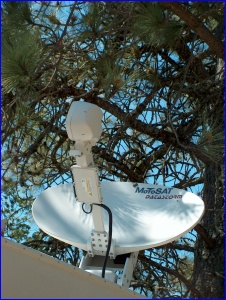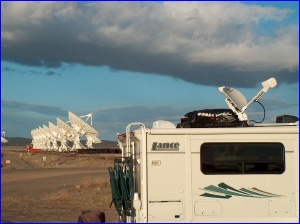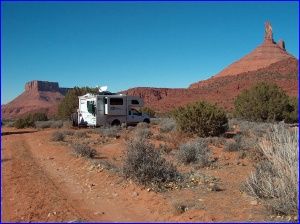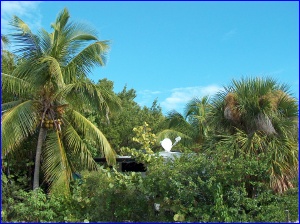

|
| [Data]Storm Warnings | Monday, 26 January 2004 |
| written by Sterling |
 Ah, the DataStorm. That whacking big satellite dish on our roof that attracts so many stares, that crucial piece of equipment that allows me to work � and thus us to live � on the road.
Ah, the DataStorm. That whacking big satellite dish on our roof that attracts so many stares, that crucial piece of equipment that allows me to work � and thus us to live � on the road.
Up until now, I've resisted putting any kind of an FAQ list on this website. I've tried to make things a bit less formal, providing information more conversationally. But this beast just seems to invite questions � I get more e-mail asking about this dish than any other topic � so I have finally given in and put together a short FAQ list for it. [Well, the list of questions is short�]
Is that an Internet dish? [Really, this is usually the first question!]
The short answer is yes. More specifically, it's a transportable, semi-automated mount for a Hughes DirecWay dish, capable of finding the satellite you need to get online from anywhere that satellite's visible. Sound nifty? It is. There's lots of hard information about the DataStorm out there, if you're interested. Look to the website of its manufacturer, MotoSAT. Look to the primary reseller of bandwidth for it, Ground Control. And definitely look to DatastormUsers.com � it's far and away the most valuable resource available to any current or prospective DataStorm owner.
It's not a television dish, then? [I'm not making this up!]
No, although the same dish can be used to receive satellite television, simultaneously with Internet, by adding a second receiver to the arm (commonly called a "bird on a wire", or BOW). We don't have one, but that's by choice � we find we're happier without TV.
What's it cost? [If someone's heard of the DataStorm, they usually know it's expensive.]
When I bought it, the hardware was $5000 + installation, which in my case was about another $650. Shortly afterwards, MotoSAT upped the price to $6000, then $7000, then dropped it to $4000, all excluding installation. It's speculated that the drop was due to anticipated competition from iNetVu (more about them later). As of this writing, most dealers are quoting $5000 including installation, which is fair.
My ongoing charges are currently $99/month for essentially unlimited use. There are no connection fees, per-minute charges, or anything of that nature. Hughes does have what they call a "fair access policy" to prevent a single user from hogging too much of a satellite's shared bandwidth, but in a year and a half I've never been limited by it.
 Although these prices may fall a bit with time, most of us believe that they're unlikely to drop very much very soon. RV Internet access is too much of a niche market for many economies of scale to be possible, and the cost of launching satellites is likely to remain high for a good long while.
Although these prices may fall a bit with time, most of us believe that they're unlikely to drop very much very soon. RV Internet access is too much of a niche market for many economies of scale to be possible, and the cost of launching satellites is likely to remain high for a good long while.
What's the blue light for?
Nothing.
How fast is the connection? Downstream speed is typically pretty good, averaging 500-800 kbps in my experience. A 5MB download is no problem at all. Upstream is another story; the sales literature quotes "up to 128 kbps" but that's a pipe dream, 20-30 is much more typical. A 5MB upload is going to take a while. Additionally, there is a latency of 3-4 seconds built into the system that makes it "feel" slow even when the speeds aren't too bad. If you're used to T1, cable, or DSL, it'll be a disappointment. No matter what the sales hype says, broadband it's not.
How hard is it to use?
The honest answer is that if you're not already pretty comfortable with computers, and pretty patient, you're going to have a rough time. On a good day, it really is about as easy as they say: park the rig, click "Find Satellite" and five minutes later you're online. But on a very bad day, you may spend an hour driving around a forested campground looking for a site with a gap in just the right direction, then two hours fiddling with the dish and trying dozens of obscure tricks before something finally works - or you give up.
In my experience, good days outnumber bad days about five to one.
 How much electricity does it take?
How much electricity does it take?
Some, but not a lot� Although the modems require 110VAC, they only use about 60W, allowing them to be powered with even a small, cheap inverter. When I'm online for extended periods, the drain on our camper battery does add up; I find that the modems and computer together use seven or eight amps. So we do some generator charging if I'm online all day, we don't have shore power, and solar-power conditions are unfavorable.
How do you like it? [Oooh, you'll be sorry you asked!]
I love what it does for us � and frequently I hate the fact that we need it.
Need it we do, it's the one item we added to the camper that makes fulltiming possible. You see, I'm the quintessential telecommuter, and I get away with it because I don't directly work for anyone else. I'm nominally self-employed, by Udell Enterprises, Inc., doing computer work from home � our home on wheels. Part of the time I'm a dot-com, and just as you'd expect, not yet profitable. :-) But much of the time I'm a software engineering consultant, with a client who doesn't mind where I am as long as the work gets done when it needs to. I was working for them from home long before we started traveling, but it was the realization that this work could be portable that made full-time traveling possible.
 The DataStorm is what provides that portability, and what's more, there's just nothing cooler than being online a hundred miles from nowhere.
The DataStorm is what provides that portability, and what's more, there's just nothing cooler than being online a hundred miles from nowhere.
But this technology is unpolished, this mount is (at best) semi-automated. You'd like it to be plug-and-play, you'd like to click "Find Satellite" and be online shortly thereafter, every time. Especially for what this beast costs. But as of this writing, that's not how it is. There are problems with the system.
Once upon a time, a company named Hughes decided to deliver Internet service via satellite, to "connect the unconnectable". The thinking was, there are lots of folks out there who'd like broadband Internet, but are outside the coverage area of DSL and cable modems. Well, with a couple of geostationary satellites, nobody is out of the coverage area. You just stick a dish on the south side of the house, pointing at the satellite, and you're online. Lo and behold, DirecPC (later renamed DirecWay) was born.
[I know, I know, Hughes is neither the first nor the only provider of such a service, but they're the provider I'm stuck with, so I'm telling their story.]
Pointing the dish at the satellite is important. Because this is a true two-way satellite service � it uses the satellite for both the downlink and the uplink � exact pointing is critical. Your average satellite TV dish, in contrast, is one-way (downlink only), and needs less precise alignment; if it's off by a couple of degrees, your picture just isn't as good. If a two-way dish is off by a couple of degrees, the uplink will miss the satellite by hundreds of miles, and won't work at all.
To further complicate matters, DirecWay uses a polarized beam, meaning that the microwaves that carry the signal are all aligned, either vertically or horizontally. If this alignment is a few degrees off (say the vertical waves are leaning a bit to the left), Hughes says it can interfere with every other vertical wave on that satellite � disrupting the connections of hundreds of other DirecWay users. Obviously Hughes doesn't want that. So they require that the DirecWay dish on your house be professionally installed, to ensure that the pointing and alignment are good enough that both you and their other users will have a good connection. In fact, they won't turn your dish on until it has passed an alignment test.
 So far, this all applies to DirecWay dishes mounted on the side of a stationary building. But enter MotoSAT, an established builder of motorized TV satellite dishes for RVs and boats � push a button and a few minutes later you're watching satellite TV in your RV, rather than cranking up a dish and trying to find the satellite by hand. Now they have the idea that they can do the same with a DirecWay dish.
So far, this all applies to DirecWay dishes mounted on the side of a stationary building. But enter MotoSAT, an established builder of motorized TV satellite dishes for RVs and boats � push a button and a few minutes later you're watching satellite TV in your RV, rather than cranking up a dish and trying to find the satellite by hand. Now they have the idea that they can do the same with a DirecWay dish.
"No way," says Hughes, "DirecWay needs too precise an alignment."
"We can do it!" responds MotoSAT, "Just watch!"
Sure enough, they did, producing the DataStorm. They built it to point and align precisely enough that Hughes couldn't complain � it was as good as or better than their certified installers could do. So Hughes approved it, and suddenly there was a real possibility for Internet access wherever you parked your RV, something that had never existed before. MotoSAT soon had people knocking down their door to get one, and realized they had a winner on their hands. This, as it turns out, is part of the problem.
Pointing this dish is a lot harder than pointing the other dishes MotoSAT builds. Hard enough that they wrote fairly sophisticated PC software to do it � but not surprisingly, MotoSAT is much better at building dishes than they are at building software. It's still pretty coarse. But because there's so much demand for the DataStorm, and because (at this writing) Hughes has yet to approve any competing product, they have little motivation to improve the software.
Also remember, the DirecWay piece that actually makes the connection was designed to be stationary. It was designed for its dish to be pointed once, and to stay connected to a PC forevermore. My DataStorm is putting the dish away every time we move the RV, and pointing the dish again every time we park it � a very different situation. But we mobile users are barely a blip on Hughes' radar screen� They have hundreds of thousands of stationary DirecWay users, while mobile numbers are still a couple of orders of magnitude below that, and probably always will be. So Hughes has very little motivation to make DirecWay mobile-user-friendly. We just don't matter enough to them. And this is the other part of the problem.
So now, we have a multi-thousand-dollar dish whose associated software is quite rough around the edges, an Internet connection that doesn't get along well with it, and little prospect of either improving in the near future.
BUT - there's still no real alternative that will get your RV online from anywhere near as many places. Cell phones are painfully slow and their coverage is far from complete. The various high-speed terrestrial wireless systems (WiFi, 3+G cellular, etc) will probably never cover outside major metro areas and their suburbs. There's C-Com's iNetVu, looks like a DataStorm but it's not, and last I heard, they've not been certified by Hughes yet. There is also KVH's TracNet: substantially more expensive than the DataStorm (especially in use), slower, and with an uncertain future due to Hughes discontinuing their 1-way service � though it will work in motion. Inmarsat's offerings are the worst of all worlds - expensive and slow, and I'll bet they still don't work under tree cover. Then there are also a few really expensive high-end systems out there, and a few vaporware consumer-level products that may or may not ever materialize.
Another option that many RVers have pursued is to get themselves certified as DirecWay installers and take a home dish on the road. Drawbacks to this include the amount of hassle, and the fact that apparently Hughes frowns on it. They can tell when a dish is moved, you see, and the only dishes authorized to move are certified Temporary Fixed Earth Stations (their term) - which right now means only DataStorms. Hughes keeps making noises about shutting down non-TFES dishes that move too often, and you never know, one of these days they just might. Or they might not, they've been saying this for years now. It's all a moot point for us - we don't have the room to carry one.
The upshot is that, for now, the DataStorm is the only Internet solution that will let us do what we do. I am grateful beyond words that it exists. I will complain about its shortcomings, I will push MotoSAT to make the necessary improvements, I will watch the marketplace and see what else might develop. But the bottom line is that if our rig was stolen tomorrow, $5000 of the insurance check would go to put another DataStorm on the roof of its replacement.
Who wants a campsite under trees anyway?
Not surprisingly, Internet connectivity has changed just a wee bit in ten years, so I've written a new article covering the revised state of the art.
Do you know someone who would enjoy this article? Click to e-mail it to them!
| Home | Log | Notes | Maps | Contact | Store |